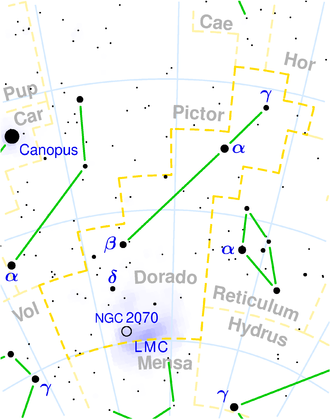NGC 1703
| Galaxy NGC 1703 |
|
|---|---|

|
|
| AladinLite | |
| Constellation | Swordfish |
|
Position equinox : J2000.0 , epoch : J2000.0 |
|
| Right ascension | 04 h 52 m 52.1 s |
| declination | -59 ° 44 ′ 32 ″ |
| Appearance | |
| Morphological type | SA (s) c / HII |
| Brightness (visual) | 11.2 mag |
| Brightness (B-band) | 12.0 mag |
| Angular expansion | 2.9 ′ × 2.6 ′ |
| Position angle | 6 ° |
| Surface brightness | 13.2 mag / arcmin² |
| Physical data | |
| Affiliation | LGG 119 |
| Redshift | 0.005090 ± 0.000010 |
| Radial velocity | 1526 ± 3 km / s |
|
Stroke distance v rad / H 0 |
(60 ± 4) · 10 6 ly (18.3 ± 1.3) Mpc |
| history | |
| discovery | John Herschel |
| Discovery date | 4th December 1834 |
| Catalog names | |
| NGC 1703 • PGC 16234 • ESO 119- G019 • IRAS 04521-5949 • 2MASX J04525214-5944319 • GC 935 • h 2678 • LDCE 0328 NED020 | |
NGC 1703 is a spiral galaxy of Hubble type Sb in the constellation Dorado at the southern sky . It is estimated to be 60 million light years from the Milky Way .
The object was discovered by astronomer John Herschel on December 4, 1834, using his 18.7-inch reflector telescope.
